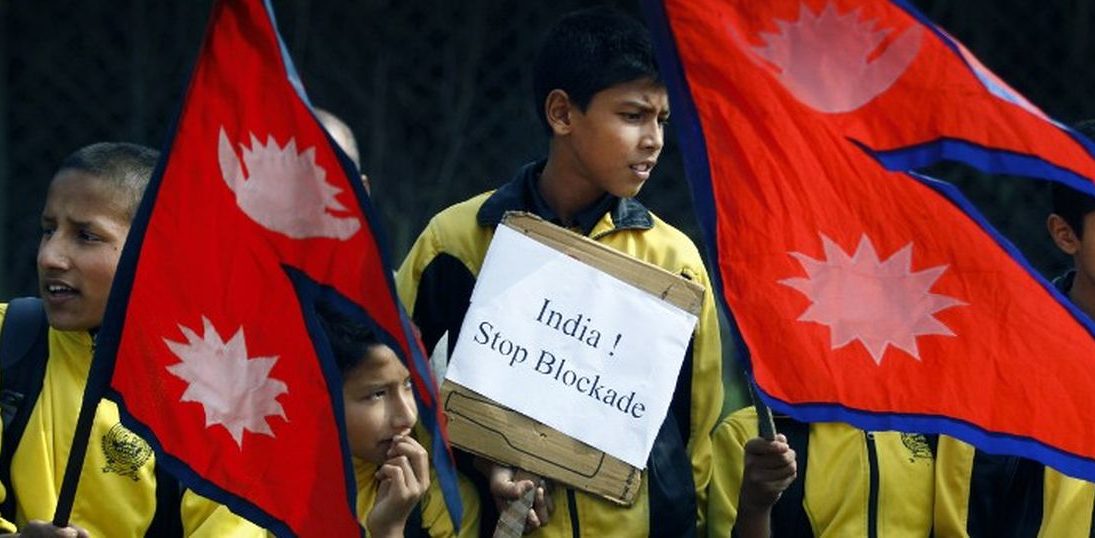
Once again, Nepal is at a crossroads. After more than a half-century long struggle, the Nepalese have finally adopted their first democratic constitution. However, contrary to people’s hopes, it has further deepened polarization between the Pahadis, people from the hills, and Madhesis, people from the southern plains. The Madhesis are upset over their demands (constituency delineation, citizenship through naturalization, and provincial demarcation) not being met within the constitution. Consequently, they are protesting at the main trading point (Raxaul-Birgunj) between India and Nepal, leading to supply disruption for the rest of the nation. Nepal has blamed this disruption on India, while India has denied these charges, instead citing “unrest” in Nepal as the cause. While India holds deep ties with people on both sides of the conflict, its support of the Madhesis in this deeply internal issue is unwarranted—especially since Nepalese leadership continues to work on a solution to balance the aspirations of different groups.
India’s ties with Nepal and Nepalese
Nepal and India have deep historic and cultural ties. The relationship between the two states is of a unique nature, marked by open borders (no visa regime), and closeness often equated to that of siblings. From direct political relations at the very top, all the way down to the common man, there is a deep cross-boundary link. However, in the present situation, this linkage has aggravated the dispute. India’s view is that the constitution was adopted amid violence, and New Delhi called upon Kathmandu to resolve any outstanding issues by enabling “broad-based ownership” (indirectly referring to the Madhesi protest). However, the Nepalese government considers Indian action as interference in their internal affairs. While it is not unusual for India to be involved in Nepal’s domestic affairs—India facilitated compromise between the monarchy and the civilian political parties in 1950, supported the people’s movement against the Panchayat system in 1990, and opposed the royal coup in 2005—it has only intervened in support of democratic forces fighting against autocratic institutions. The present instance is more problematic as the dispute is among democratic forces, and it appears that India is taking sides. Given India’s deep ties with people on both sides of the conflict, taking a partisan role will surely affect India’s diplomatic leverage over alienated sections of society.
Though Madhesis have family ties with India, it is equally true that the rest of Nepal also shares strong cultural and linguistic links with the country. Pahadi people have historically defended Indian territorial integrity, including in difficult times such as during the reintegration of Hyderabad into India. Furthermore, a large number of Nepalese still serve in the Indian army. Most Nepalese members of the Indian army are Pahadi, despite the anti-India tag sometimes ascribed to them. New Delhi siding with the Madhesis—who are seen as the fifth column of India within Nepal—will further antagonize other Nepalese against the country. This opens the future possibility of the exploitation of anti-Indian sentiment by competing foreign powers, like China.
Diplomacy in the Age of Social Media
India’s diplomatic mission in Nepal and South Block (India’s foreign ministry) seem to be of the opinion that given the integrated nature of the relationship between the two neighbours, relations will recover with time. However, it’s not quite that simple. Unlike the monarchical era, it is no longer possible in the Nepalese republic to simply deal with power brokers and achieve a quick fix. Due to the entrenchment of democracy and accessible mass media, including active social media use, public opinion cannot be taken lightly by the government. Furthermore, Nepalese youth, unlike the older generation, are no longer constrained by religious affinity to India, and see economic benefits as their main concern. With the deep scar left in relations with New Delhi by the current standoff, combined with growing Chinese interest, there seem to be legitimate reasons for Kathmandu to consider Beijing as an alternative.
Short-sighted Action
A nation’s constitution encompasses the combined aspirations of countless distinct sections of society, who often possess conflicting goals. Naturally, no single group can be fully satisfied during the constitution-making process. Unlike religious books that are immutable, a constitution can be amended. The Nepalese Constitution, like any other modern constitution, has scope for amendment, and continues to be amended. The issues involved in Nepal’s constitutional row are complex and have long-term implications. They need to be dealt with carefully, through proper research and public discussion. The institution and culture of democracy has never succeeded by imposition, and Nepal should be given time to develop its democracy. It is true that Nepal’s constitution is not perfect and needs changes, but India taking sides is uncalled-for, and complicates the issue.
Considering its status as a regional power, India should exercise more caution regarding its diplomatic manoeuvring with sensitive immediate neighbors. South Block has claimed diplomatic success in getting many countries, including the United Kingdom, to state that the Nepalese constitution needs to be more inclusive. But it has failed to convince other SAARC nations to support its position. Nepal has struggled since the early 1950s to have a constitution drafted by the people, and this has finally been achieved. For this achievement, Nepal deserves appreciation, not merely to be noted by its neighbor and well-wisher, India.
***
Image: Strdel-AFP, Getty